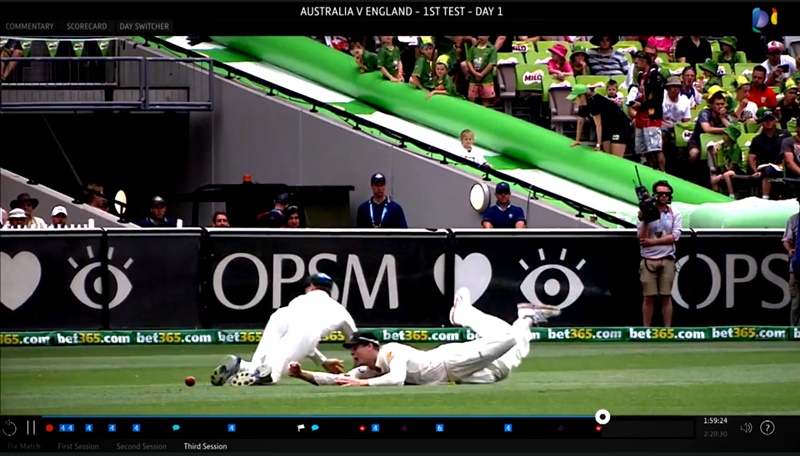Is Test cricket dying because it’s unsuited to modern life? Or is it being allowed to die because it’s harder to monetise?
Doom-mongering administrators often talk like the world’s moved on from Test cricket. They say no-one’s interested any more and nothing can be done to save the format. They say they’ll do what they can for the patient, but the sad fact is a five-day cricket match doesn’t fit into modern life.
This is misleading and ignorant. The only question is whether or not they know it.
Do you know what a TRP is? Be thankful if you don’t. It is the kind of thing it is better not to know. We’re going to explain what a TRP is in a second, but please try and expunge the meaning from your brain once you’ve finished reading the article because if you ever find yourself talking about TRPs, you’ve definitely taken a wrong turn in life.
A TRP is a ‘target rating point’. It’s a marketing term. It means the percentage of your target audience that you actually reached through a given communication medium.
In 2019, ICC chairman Shashank Manohar confidently stated that, “Test cricket is actually dying.”
To justify that position, he said: “If you look at the TRPs of the broadcasters, T20 has the maximum TRP. It is because of being the shorter version of the game. Nowadays, people don’t have five days to watch a Test match. From 10 to 5 everybody has their own job, it is very difficult for them to watch this game. T20s get over in three-and-a-half hours, like watching a movie. Therefore, it is picking up very fast.”
Okay, there’s a few things to pick up on here.
Firstly, and most importantly, “10 to 5” – what the hell is that? Do you honestly think those are standard working hours, Shashank? You’re ICC chairman. How about working a full day for once in your life?
Secondly, “nowadays” – are people really busier these days? People have always worked. People have always had family and friends. If people are busier now, they’re busy wasting all the extra free time that’s been generated by all the millions of labour-saving devices they possess.
Thirdly, the biggest error Manohar’s made here is that he’s equated a format’s popularity with how many people watch it on TV at any given moment during a match. And you know what? That’s completely wrong.
You can see why he thinks this. From Manohar’s perspective the success of the sport is measured by how much money it makes and currently how much money the sport makes pretty much hinges on what TV companies are willing to pay to broadcast it.
But that’s not an accurate measure of interest. That’s a very, very inaccurate measure of interest.
There’s an episode of the X-Files that’s about an alien who played baseball for the Roswell Grays in 1947.
It’s not an especially good episode – it’s probably even a bad one – but it has a very important moment in it when Mulder’s reading some old scorecards.
“Reading the box scores, Scully. You’d like it,” he says. “It’s like the Pythagorean Theorem for jocks. It distils all the chaos and action of any game in the history of all baseball games into one tiny, perfect, rectangular sequence of numbers.
“I can look at this box and I can recreate exactly what happened on some sunny summer day back in 1947. It’s like the numbers talk to me, they comfort me. They tell me that even though lots of things can change, some things do remain the same. It’s…”
And then Scully says, “Boring,” because most people don’t appreciate the subtleties of the scorecard.
No-one’s measuring the target rating points of old cricket scorecards from 1947, but that doesn’t mean people aren’t still spending time poring over them.
People also spend a hell of a lot of time poring over new scorecards – generally online. This is probably the most fundamental way in which Test cricket is followed these days. Millions of people monitor Test match scorecards. It is just that this is a mode of consumption that is very hard to monetise.
And that’s not all.
It’s even harder for cricket to make money off people talking about Tests in the pub. It’s hard for it to make money off people talking about them online too. Even the little video snippets of boundaries and wickets that everyone shares on social media are worth a pittance compared to showing a match on TV.

All of this non-broadcast consumption applies to all cricket formats these days, but Test cricket lends itself to highlight snippets and general debate far more than the others simply because of its duration. Only a small proportion of a Test match’s total audience will be sitting and passively watching the action at any given moment. Plenty of people are still hooked though – it’s just that each of them has a much lower dollar value attached to them.
You can’t write one of these articles without at some point asking, ‘does cricket exist to make money or does it make money to exist?’ so let’s get that out of the way now. Much as we might like it to be the latter, administrators can’t ignore financial pressures. The best cricketers want to make a decent living and even if every last one of them felt the longest format was the most important, there’d come a tipping point for each of them – no-one’s playing for free.
But let’s be clear: none of this amounts to Test cricket failing to fit into modern life. This is not that at all. This is a failure to monetise a format that fits into modern life perfectly.
Do you know what dot-watching is? Dot-watching’s watching a dot move across a map.
It sounds dull, but when the dots represent the positions of different people and they’re involved in a very long race, it can become weirdly absorbing. It’s a misleading term though because you don’t generally just sit there and watch the dot move.
Dot-watching has become increasingly popular as a way of following endurance events, in particular ultra-distance bike races like the Transcontinental Race, the Tour Divide or GBDuro – races that typically involve riders travelling great distances, carrying all their own stuff.

These kinds of races last days or even weeks. Finishing is an achievement and you’re more likely to get overtaken while sleeping than on the road. Quite often riders are allowed to choose their own routes. In the Transcontinental, for example, these route decisions might see them travel through entirely different countries. Rider A might take the direct route over a mountain range, while Rider B might skirt round and go through the foothills.
This means that if you’re following the race, there’s a lot to ponder. You check the map, you see who’s stationary and who’s moving. You compare recent speeds, you look at terrain – and then you get into all their social media stuff.
An ultra-distance bike race is a series of stories. The dots are the starting point and then you delve in as deeply as you want to. As a sport, it’s fascinating, but you absolutely do not sit and watch it. You couldn’t – it’s literally an endurance challenge.
Test cricket is not like this. There are endurance elements, but the play itself is a lot more inherently watchable than a person endlessly pedalling a bicycle. There are similarities though.
There’s this idea that everything in the modern world has to be instant and fast. What many people don’t seem to realise is that you can instantly and quickly monitor slow-paced things.
Most cricket broadcasters have apps these days and some are a lot better than others. We’re slow on these things, so the first time we really got a sense of what was happening was during the 2017/18 Ashes Down Under when we got free access to BT Sport’s offering through our phone contract.
The BT app seemed like a good one. We’d wake up in the morning and the app would have the whole day’s play on it with boundaries and wickets tagged in the timeline. We’d slide around, watching whatever took our interest. We’d catch up with the match interactively, in our own way. Then maybe we’d read an article elsewhere, or see what people were arguing about on Twitter.
You can do a lot more than this nowadays. With apps like CricViz, you can delve deeper into the scorecard. You can investigate how much the ball has been swinging and seaming. You can see how accurate the bowlers have been or get a sense of how many false shots the batsmen have played.
Follow a game this way and Test cricket doesn’t feel slow and unsuited to modern lifestyles: it feels immediate and brilliantly adaptable. You have access to as much or as little information as you want.

At the exact same time, Test cricket can be an ambient thing, something you dip in and out of. You can keep track of the score at work; you can follow it ball-by-ball on your phone on the bus; you can half watch it and half not-watch it on the TV, looking up only when you hear a noise to watch the replay.
The only people who really, really absolutely have to devote great slabs of time to actively watching cricket are the people who are new to the game. While many of us can hear a radio commentator say that a full-pitched away-swinger’s been driven through the covers for four and instantly visualise it, if you’re new to cricket then that description is just a near-meaningless series of sounds. You learn the game by playing it and watching it and building all of that specific knowledge.
If you’ve already made that investment, Test cricket is perfect for a reduced attention span. You can talk over it. You can keep tabs on it in the pub. You can prat about on Facebook or scour Rightmove while it’s on in the background at home. Almost anything you’re doing, Test cricket can creep in and lurk alongside you, giving you a nudge whenever something significant happens.
Modern technology means that you can carry the story of a Test match with you wherever you go. You can keep track of developments almost effortlessly and then, when time allows, you can get instant gratification. You can arrive in the middle of a Test and gain access to two days’ of footage and data – you can actively catch up.
You don’t need patience. You don’t. You absolutely don’t. Test cricket can be instant and immediate but also deeply absorbing in a way few other forms of entertainment can.
There has never been a better time to follow Test cricket and there has never been a better sport to follow.
Whenever anyone says that Test cricket doesn’t fit into modern life, ask yourself what they really mean.
First published in March 2020.
Thanks to everybody who’s currently funding King Cricket on Patreon. Your pledges help us do features like this. If you’re not currently a King Cricket patron and you’d like to see us to do more with the site, you can flip us a shiny coin or buy us a pint each month here. Don’t feel you have to, but huge thanks if you do.





A feature on Test cricket in all – new, all – white clothing. Nice!
Oh yeah!
Super posting.
I have long thought many of the points you make here but never had the skill, temerity or skilful temerity to write those thoughts down. Extremely well writ.
I have made a mental note that THIS posting of yours is the thing I should send people to read if/when I get that “test cricket is not for the modern lifestyle” challenge thrown at me.
There is one further point which isn’t in your piece, which is that test cricket is harder to monetise now than it was in days of yore. But that is so, in large part, for the very reason that the game has developed versions that are easier to monetise.
Cheers!
Viewed holistically, with the shorter formats supporting the longest one, the game’s in great shape. It’s just no-one really views it that way.
This is like when England moved to ‘white whites’ from ‘cricket whites’ (in 2009, I think?) it made everyone else’s whites look a bit yellow
I haven’t read the article yet as it’s a bit long for work, but I really like the look of the new site.
That’s promising. Thanks for saying so. We’re sure there’ll be issues. It’s whether the positives outweigh them really.
Was this a “Patreon” piece?
I liked it.
Yes, it was. We were hoping our Patreon copy was prominent enough, but maybe it isn’t.
Great piece, KC!
A couple of thoughts: first, your last section is so bang on accurate it’s amazing. Well done!
Second (and I swear at some stage I thought this was related but I’m starting to think I’m just musing off on my own): I find it odd that PGA Tour Golf is so easily accepted as a multi-day event and yet Test cricket is not fit for modern life. Like Tests, major golf tournaments have ebbs and flows – players appear in control for a couple of hours at a time, but a couple of strategic errors or just plain fuck ups can swing things around. Often what is so exciting about (e.g.) The Masters is how it takes 4 days of close, competitive golf to get an exciting conclusion.
Indeed, most people can’t watch the first two days of a golf tournament because of that whole job thing. They can do what you outline in the last segment – watch detailed highlights, see who shot from where when and how it went. Lots of people love lazing around on a Saturday and Sunday watching golf. Why not Test cricket? (Of course, golf is embedded in broader society – particularly US society – in a way that cricket is not, but I’d hate to ruin a good ramble with a cogent counterpoint).
Third (yes I have gone off to the beat of my own drummer): it seems of the utmost importance that how one in fact interacts with Tests be monetized in order to show administrators that the format can make money. Sadly, this may well ruin the best ways to follow Tests: more adverts on the radio, ads between overs on the cricinfo ball-by-ball, or even – and this one scares me the most – hiding ball-by-ball and similar behind paywalls. Unless the goal for admins stops being to make more money, this seems to be the way forward. God I hate myself for suggesting it at all.
PGA Tour golf: the golf admins are always trying to re-invent the game – and discover the “Twenty20 of golf”. They are wrestling with the same dilemmas. But the existing format works, people keep watching, despite these attempts.
Really enjoyed reading this detailed article, KC. Great stuff. Glad you focused on 1947 as the Wisden of that year relays the marvelous story of Major Bennett.
Not keen on the glaring white I’m afraid. I felt the same when the street lights around here went Sodium.
I have always thought the constant “test cricket is dying” comments referred to attendances rather the TV rights. Is there anywhere that cricket boards are struggling to sell the rights to test matches? Or at least losing money by bundling them with other formats?
What stood out to me is something neither you nor, more pertinently, Shashank Manohar said: whether test cricket has a bad TRP. Manohar only says that the one for T20 is better, but they are obviously not the same thing.
Look how many sports are shown on sport networks around the world, and despite that how much time on them needs filling. You do not have to be most popular, or even the fifth most popular, sport to be valuable to a broadcaster or interesting to an audience.
And that is not to mention the demographic value of an audience, which I would assume is more upscale for test cricket than T20. Reaching small but unqiue audiences with high disposable incomes can bring in new advertisers and be just as valuable as a larger mainstream audience which is already being reached through other programming.
The feeling I get from the ICC is they just see test cricket as a hassle, possibly because it is not suited to tournaments so they cannot directly monetize it themselves. The international schedule now has the ICC holding both a men’s and women’s limited over tournament every year. But for test cricket all they have managed is to host one men’s test match every few years. It is no wonder Manohar’s enthusiasm for the format is lacking.
What! Bikers can choose their own routes?
I have many questions
Is there a mechanism to stop them from cheating like attaching a booster motor when they are on an offbeat trail ??
Perfectly pitched (awww, but of a rum pun) piece KC.
I have an attention span of an adolescent gnat, fairly impatient too. I first glimpsed Test cricket on a family black & white analogue tv in the ‘70’s when the infamous West Indian ‘Four Pacemen of the Apocalypse’ were firing bullets around Brian Close’s eats. It was gripping, gladiatorial and seemed the next closest thing to watching Muhammad Ali bring an opponent to his knees.
Test cricket, or at least the 4-day red ball format, by dint of the fact it’s been the host donor of myriad variants, derivations and off-shoots, should at least be credited as such. It’s birthed the hybrids that the game has readily, rightly and richly monetised. There are spurious and laboured arguments against its continued existence. It remains the ultimate ‘test’ because it demands so much of its athletes.. Try telling an opponent just what the body feels like after bowling 25 overs on successive days. It’s akin to completing a marathon. It drains body, mind & soul.
Although I remain a Test advocate. A Scottish pal of mine & I spent two days at Headingley for Days 3 + 4 of the 3rd Ashes Test last year. Granted, we were witness to an extraordinary sporting spectacle. We analysed various tactics and individuals’ strengths and weaknesses (giving Nathan Lyon some obligatory ‘what-for’). However, for the most part we chatted, drank, read the newspapers, strolled, shopped, spouted drivelling opinions, texted friends & family, scoured twitter and ruminated on topical affairs. I’d not been to a Test match in years precisely for the reasons you deftly articulate. It’s as compelling to craftily track bits of sessions via CricInfo and re-paint the picture for colleagues most of whom have only a passing interest in the game. I shared a clip of an Flintoff over with a German physiotherapist friend via WhatsApp recently. He wouldn’t be able to tell a cricket bat apart from a tent mallet, but he now wants me to show him how to play on a beach in Cornwall this September.
As was said of Stalin, we all know that if someone could show Trump, Putin and Kim Jong-un what Test is all about the world would be an infinitely better place. Tell the global sport’s administrators to put a price on that!
Excellent piece KC.
Would request that the entire site be white if that’s the colour of choice. I can see two bands of the earlier colour on either side of the page (not sure if that’s just me), and that jars a bit.
Yeah, I think you’re right. Was half thinking about bringing the baby poo yellow back for the content too, but it’s probably time to move on.
This looks nicer, with everything being the same colour.
Re the actual post, after thinking about it a bit more, it isn’t a case of tests being harder to monetise, but broadcasters are still thinking in terms of TV broadcasts, and we are in a post-broadcast world (apologies for using post-).
They should be looking at giving access to well produced highlights packages of varying lengths and other such things. I can’t spend an entire day watching cricket anymore. I can, however, spend an hour or so watching highlights, especially on my commute. The technology exists to give me access to hour-long highlights for, say, £2/match. You could say that this is more work, but every single broadcaster already creates this content. Why not monetise it?
This is exactly what everyone wants, plus the ability to pay for only this and not 345 Premier League football matches as well.
I don’t mind the new colour scheme of the site, but I used to like the fact you could see how many comments had been left by just visiting the home page.
Yeah, we miss that. That might be a ‘fiddling with the code’ thing.
Still needs a fiddle, at risk of Carry Onning myself.
Still a great piece. Which is a shame. If people weren’t banging on about monetisation as if it and life were the same thing it’d be irrelevant now, and not a great piece. But they are so it’s not so it is.
What a poetic final sentence.
Oh dear. I read all the way through this with a queasy, deja vu feeling, reaching the punchline “first published in March 2020” just ahead of (probably) falling off my perch.
I know the piece is making a global point, but KC readers who haven’t read Mike Atherton’s interview with Richard Gould last year might wish to read it, now that the latter has been appointed ECB Chief Executive. Interesting thoughts on tests & the Hundred:
https://www.skysports.com/cricket/news/12152/12312809/richard-gould-talks-surrey-crickets-challenges-and-the-hundred-as-he-prepares-to-leave-the-kia-oval
We might be in for a change of tack over the next few years, at least here in Blighty.
Thanks for that. Sometimes it’s worth revisiting the same thing at a different time as you see it in a different context. This article (hopefully) and that interview both fall into that category.
Indeed yes. In March 2020 I (along with everyone else in the world) had other things on my mind – not least the global pandemic unfolding before our eyes.
In October 2022 I have other, other things on my mind.
The phrase “anti-growth” has been doing the rounds a lot recently in the UK political/economic context, spat like an insult at people like me. People who are not anti-growth at all, but simply question whether growth-for-growth’s sake is a universally good thing and who question what exactly we mean by growth or exactly how we might measure it.
Cricket could do with similar deep thought. Growth in the coffers of a cricket administration monolith is not necessarily a good thing for the game. It is fair to argue that it is a bad thing if the inevitable consequence of focussing only on “size of cricket administration/management budget” measurement is that “size of cricket participating population” resultantly goes down.
Organisations so often seem to suffer from ever increasing emphasis on one particular metric or other. Something easily measurable and comprehensible is identified as The Most Important Thing and then all the other stuff is compromised in pursuit of growth in this very specific area.
The curse of the KPI.
I don’t remember reading this first time around, never mind commenting on it.
Top stuff, KC from the past.